Sony Alpha DSLR-A330
-
-
Written by Gordon Laing
Sony Alpha DSLR-A330 focusing, sensor and drive
The Sony Alpha DSLR-A330 employs an A-mount for lenses and is compatible with the complete range of Sony lenses and third party models designed for the Sony or Minolta AF systems, including Sony’s DT models. Like the most recent Alphas, the polished metal surface of the lens mount extends a few millimetres beyond the trademark Alpha orange ring.
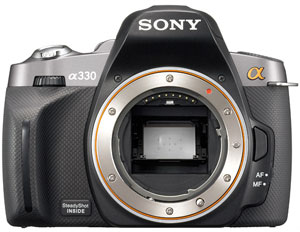 |
All lenses attached to the A330 can exploit the camera’s built-in SteadyShot stabilisation, and since the A330 employs the same physically sized sensor as previous cropped-frame Alphas, all lenses effectively have their field of view reduced by 1.5 times.
 | ||
The Alpha A330 is available body alone, or in one of two bundles with either the DT 18-55mm f3.5-5.6 SAM alone or this and the DT 55-200mm f4-5.6 SAM in a twin lens kit. Both lenses are new models introduced alongside the A330 and its siblings, with the DT 18-55mm SAM replacing the ageing DT 18-70mm inherited from the original Konica Minolta merger.
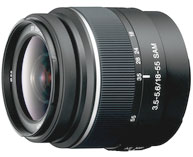 |
The new DT 18-55mm SAM looks, feels and operates much like rival 18-55mm kit lenses. As you zoom from wide to telephoto, the barrel retracts and extends again, with the physically shortest position around the 35mm focal length.
There’s no manual focusing ring to speak of, so like other kit lenses, you’ll be grabbing and rotating the narrow end section. This section therefore also rotates during autofocus, which means users of polarising filters may need to readjust after focusing.
The big new feature of these latest lenses is the SAM designation, short for Smooth Autofocus Motor. This means there’s an AF motor built into the lens, which suggests future Alpha bodies may dispense with their own AF motor to save money and weight, like Nikon’s entry-level models.
Don’t expect equivalent speed and operating noise to Sony’s higher-end SSM lenses though – in terms of focusing speed and mechanical noise the DT 18-55mm SAM is pretty much the same as Canon’s EF-S 18-55mm IS. See our results and gallery pages to see how this new kit lens copes with the demands of the A330, and check out our video tour to see and hear its AF speed in practice.
Sony Alpha DSLR-A330 SteadyShot Stabilisation
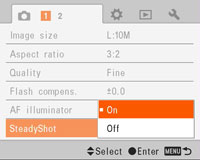 |
Like all Alpha DSLRs, the A330 is equipped with sensor-shift image stabilisation to combat camera-shake. This moves the entire sensor platform in two axes and is branded by Sony as SteadyShot. Like the previous generation, Sony claims the system is good for between 2.5 and 3.5 stops of compensation depending on the lens and shooting conditions, although it’s now enabled or disabled from a menu option rather than with the physical switch of earlier models.
As with all sensor-shift stabilised solutions, the major benefit is that it works with any lens you attach, new or old, wide or long, prime or zoom. The downside is that you won’t see the stabilising effect through the optical viewfinder, which can be annoying when framing at longer focal lengths. And due to the way Sony has implemented Live View on the A330, you won’t see a preview of the stabilising effect on-screen either. Like other Alphas, there are at least indicators in the viewfinder (and in Live View) which show how hard the system’s working, or when it’s gone beyond its capabilities.
To test the effectiveness of the A330’s built-in stabilisation we took a serious of photos with the 18-55mm zoomed-into an equivalent of 83mm where traditional photographic advice would recommend a shutter speed of approximately 1/80 to eliminate camera shake. Our sequence started at 1/80 and reduced by one stop each time until 1/5.
| Support this site by shopping at Amazon | ||||||
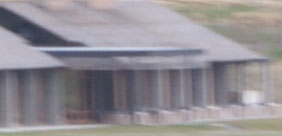 |
Sony Alpha DSLR-A330 with DT 18-55mm SAM: SteadyShot off / on | ||
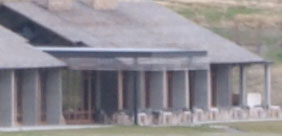 | ||
100% crop, 18-55mm at 55mm, 1/10, 100 ISO, IS off |
100% crop, 18-55mm at 55mm, 1/10, 100 ISO, IS on | |
Under the conditions of the day, we required the recommended 1/80 shutter speed to avoid camera-shake with stabilisation disabled. With stabilisation enabled, the images remained almost 100% sharp down to 1/10, with significant blur only coming in at 1/5 and slower. As such, the degree of stabilisation achieved in this situation was three stops – halfway through Sony’s quoted range of 2.5-3.5 stops.
As always, the success of any stabilisation system is highly dependent on the operator and the conditions of the day, but the three stops measured here is certainly not to be sniffed at. And while you may not be able to preview the effect of the A330’s stabilisation on-screen or through the viewfinder, you’ll be able to exploit it on all lenses, including shorter primes. It’s a highly valuable ally.
Sony Alpha DSLR-A330 focusing
The Alpha A330 is equipped with the same 9-point AF system as its predecessor with a centre cross sensor, and like earlier Alphas, the system can be started as you look through the viewfinder; this can indeed save time, but many DSLR traditionalists will prefer to switch it off and go for a half-press of the shutter release instead. As described on the previous page though, Sony’s switched the previous line markings in the viewfinder for more conventional squares indicating each focusing point.
 |  |
As before you have the choice of single-shot AF-S, continuous autofocus AF-C, or the default AF-A mode which automatically switches between AF-S and AF-C. Unlike the higher-end A700, there’s no AF clutch on the back of the A330, so unless you’re using a lens with full-time manual focusing capabilities, you’ll need to switch from AF to MF manually. If the lens is a SAM model like the new kit lenses, you’ll need to use the switch on the side of the lens barrel, otherwise you’ll use the switch by the lens mount.
In use with the latest kit lens, the A330’s AF performance felt similar to rival DSLRs fitted with their kit lenses. It’s certainly adequate for general use, but nothing special, and like rival models you’ll need to upgrade to a higher-end lens to enjoy quicker and quieter auto-focusing.
One interesting point worth noting though is since the normal phase-change AF system is used during Live View, you also get to use Continuous AF when shooting with the screen – this is unlike existing DSLRs, which are unable to continuously autofocus while in Live View. So in theory you could recreate the Sony ads where moving subjects are tracked when composing with the screen, although the paltry 2fps continuous shooting speed in Live View will certainly limit any serious action photography. Even switching to the optical viewfinder doesn’t improve matters significantly, with the A330 shooting at a maximum of 2.5fps – see section at the bottom of this page for full details. If fast action shooting is important to you and you’re hooked on the Sony brand, it’s worth trading-up to the Alpha A500 or A550 which both offer 5fps continuous shooting, boostable to 7fps on the A550 if you’re willing to sacrifice AF.
Sony Alpha DSLR-A330 metering, exposures and bracketing
 |  |
The Sony Alpha DSLR-A330 offers the same three metering modes as its predecessor: 40-zone Multi-Segment, Centre Weighted and Spot. As before, we used Multi-Segment metering for all our sample images and found very few occasions when we’d want to apply any compensation.
The Alpha A330 offers shutter speeds from 1/4000 to 30 seconds plus a Bulb option; the fastest flash sync speed is 1/160. Like most non-pro bodies, there’s no figures quoted for the longevity of the shutter block.
Exposure bracketing is available with three frames at either 1/3 or 2/3 EV apart. This is pretty basic, as while most entry-level models also don’t offer more than three frames, they generally allow steps up to 2EV apart.
Sony Alpha DSLR-A330 anti-dust
Like all Alpha DSLRs to date, the A330 uses its sensor-shifting mechanism to double-up as an anti-dust system. This vibrates the sensor during power-off in an attempt to shake-free any foreign particles. The sensor filter also has an anti-dust coating.
Following our usual DSLR torture-test we left our A330 face-up without a lens, inside and outside for ten minutes each, before powering it up and down twice, then searching for dust; we can’t know how much dust entered the body during this time, nor even how much was present to start with, but we know such a process would result in dust being a problem for most models.
We then took a series of photos at every aperture setting of a plain white surface at close range with the DT 18-55mm lens zoomed-in and focused to infinity. Dust marks normally become most apparent at the smallest apertures (eg f16 and f22), but it’s also important to test at more common apertures.
| Support this site by shopping at Amazon | |||||
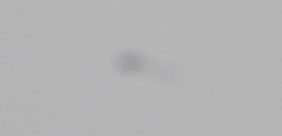 |
Sony Alpha DSLR-A330 dust example at f22 / f8 | ||
 | ||
100% crop, 18-55mm at 55mm, f22 |
100% crop, 18-55mm at 55mm, f8 | |
At f22, a number of dust marks were clearly visible, and we’ve shown a 100% crop of a typical offender above left. As always, these marks became more diffuse and harder to sport at larger apertures, and by f8, the same mark had almost disappeared – you can see a crop of the same area above right.
This is a fairly average result for the A330. The sensor-shift system failed to displace a number of marks, forcing any owner who wanted a clean frame into flipping open the mirror for manual intervention with a blower. Interestingly the A380 actually performed much better in this process, although we believe their anti-dust system to be the same – so we can only assume this was either a lucky result for the A380, or of course an unlucky one for the A330. As always, dust measurement is not an exact science, and all we can do is gather anecdotal evidence to build up a bigger picture. But judging on this result alone, dust marks can be a problem for the A330 and anyone who swaps lenses regularly will need to invest in a blower – we recommend Giotto’s Rocket, as seen in our DSLR Accessory Guide.
Sony Alpha DSLR-A330 sensor and processing
The Alpha A330 is equipped with the same 10.2 Megapixel CCD sensor as its predecessor, measuring 23.6×15.8mm. It generates 3:2 aspect ratio images with a maximum resolution of 3872×2592 pixels and there’s the choice of two lower resolutions at 5.6 and 2.5 Megapixels respectively. A cropped 16:9 aspect ratio is available in 8.4, 4.7 and 2.1 Megapixels. The sensor resolution is the major difference between the A330 and its slightly pricier counterpart, the A380 which features 14.2 Megapixels.
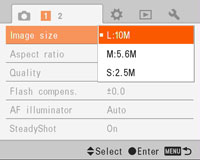 | 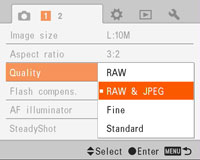 |
Images on the A330 can be saved with Standard or Fine JPEG compression, or recorded as a RAW file either by itself or accompanied with a JPEG.
Best quality Large Fine JPEGs typically measure between 3 and 4MB each, while RAW files typically measure 12MB each. There’s no dedicated button for the quality settings, but it’s easy to adjust them using the main menu as they’re the first items on the first page.
As before, the sensitivity runs between 100 and 3200 ISO, with High ISO noise reduction applied by default at 1600 and 3200 ISO, although you can disable this if desired. Long exposure noise reduction is also enabled by default, applying to exposures of one second or longer, although again this can be disabled if preferred; you can see how the A330 performs across its sensitivity range in our High ISO Noise results.
 | 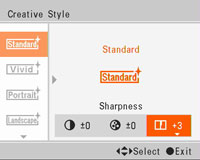 |
Colour, contrast and sharpness are applied using a number of Creative Styles, chosen from the Fn menu system.
Along with the default Standard setting, you can choose from Vivid, Portrait, Landscape, Night View, Sunset and Black and White; in the colour modes you can adjust contrast, saturation and sharpness in a range of +/-3 steps, but there’s still no filters for Black and White.
Like other Alphas, the A330 is equipped with Sony’s D-Range Optimiser feature which can adjust the tonal range as you record the image. As before, there’s three choices: D-R Off, D-R Standard, and D-R+. We used the default D-R Standard for all our test shots, although have presented two shots taken with it disabled and at the maximum D-R+ setting for comparison below.
| Support this site by shopping at Amazon | |||
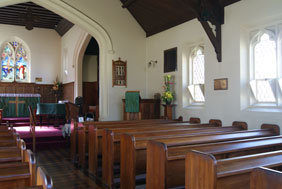 |
Sony Alpha DSLR-A330 Dynamic Range Optimizer: Off / D-R+ | ||
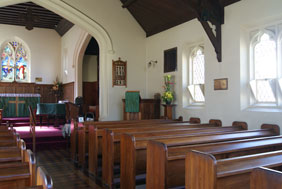 | ||
 | 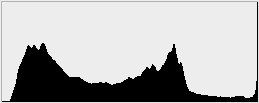 | |
DRO: Off, 100 ISO, f8, 1 sec |
DRO: D-R+,100 ISO, f8, 1 sec | |
The effect was subtle to say the least, and even examining the histograms reveals very little benefit for this particular composition; indeed rather than retrieving highlight detail, the windows are actually more washed-out on the D-R+ version. You may have more success with DRO on the A330, but in our tests it offered little which couldn’t be achieved with careful exposure and tweaking in software later.
There’s no evidence that the A330 corrects for coloured fringing or vignetting on in-camera JPEGs, but we’re checking with Sony.
Sony Alpha DSLR-A330 drive modes and remote control
The Sony Alpha A330 offers one Continuous Shooting mode rated at 2.5fps with the optical viewfinder or at 2fps in Live View; the rate with the viewfinder is actually a little slower than the 3fps quoted for its predecessor the A300. Sony quotes a maximum buffer of three frames in RAW+JPEG mode, six in plain RAW mode, and no limit for recording JPEGs.
 |
To put this to the test we fitted our A330 with a high-speed Lexar Professional 8GB SDHC card. We fired-off 47 Fine JPEGs (100 ISO / DRO Standard / AF-S) in 20 seconds using the optical viewfinder, corresponding to a rate of 2.35fps. Switching to Live View saw this fall to 35 frames in the same 20 seconds, corresponding to a rate of 1.75fps. In RAW mode using the optical viewfinder we fired-off 15 frames in 7.8 seconds before the A330 stalled – this works out at 1.9fps. Shooting RAW in Live View we measured the same speed of 1.75fps.
So when shooting JPEGs with the viewfinder, the A330 (like the A380) fell below the quoted rate, albeit not to the same degree as the paltry 1.95fps we measured from the A380 under the same conditions. But 2.35fps remains much slower than the 3fps JPEG rate we measured from the Canon EOS 1000D / XS, not to mention the 2.9fps measured from its predecessor. And if you switch the A330 to RAW or Live View modes, the rate falls below 2fps.
So while the JPEG rate with the viewfinder was faster than the A380, it’s still not sufficiently quick for capturing action sequences, despite how the consumer Alphas are often advertised. If you’re after something quicker in this respect, consider Canon’s EOS 500D / T1i or the Olympus E-620 which deliver around 3.2fps in practice, or Nikon’s D5000 which speeds along at its quoted 4fps. Or better still, go for one of Sony’s mid-range A500 or A550 Alpha DSLRs which deliver 5fps, boostable on the A550 to 7fps if you’re willing to sacrifice auto-focus.
In terms of other drive modes, there’s the choice of two or 10 second self-timers, but still no mirror-lockup facility. The drive menu is also where you’ll find bracketing options, although as described above, they’re fairly basic with the choice of shooting three frames at either 0.3 or 0.7 EV apart. The White Balance bracketing of the earlier models is also now absent.
Now let’s see how the Alpha A330 compares in terms of real-life resolution and noise levels in our results pages.



